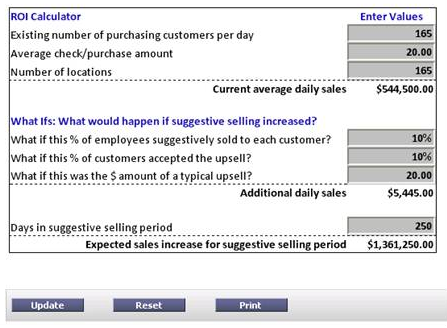
Of course, each company’s objectives ultimately determine how ROI will be calculated. Mystery shopping programs typically focus on customer retention, loyalty, and revenue-generating behaviors such as suggestive selling. Some factors to consider include:
- Incremental revenue expected from earning repeat business from current customers
- Improved speed to results, because what gets measured gets done
- Reduction in employee time spent handling customer complaints, as service levels improve
- Reduced cost of bringing in new customers
- Increase in referrals from existing customers as service levels improve and are more consistent
- Increase in revenues from additional products/services sold
- Increase in employee retention and morale as excellent service results are consistently recognized, leading to a decrease in employee turnover
Regardless of the industry, this tool can be adapted to any scenario. Here’s an example of a retail store with 165 locations. It shows the impact that mystery shopping, which encourages suggestive selling, can have on their bottom line. With the calculator, the store estimates the increase in percent of employees who will suggestively sell if they know a mystery shop program is in place to measure this behavior. Next it looks at the percentage of customers that might accept the upsell and the dollars associated:
Take a look at Confero’s ROI Calculator to learn how your company may increase ROI through customer experience measurement programs.

